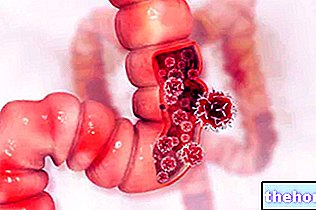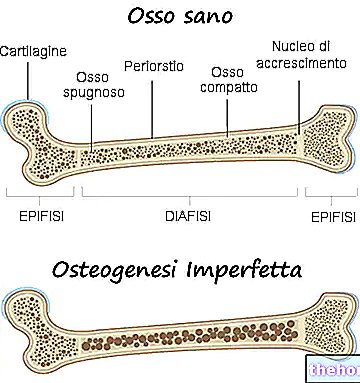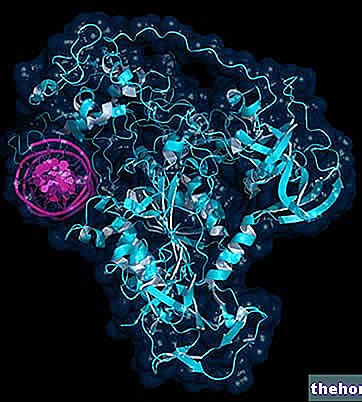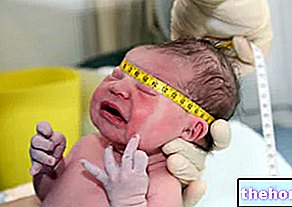The cause of Duchenne muscular dystrophy is the mutation of the gene coding for dystrophin, a protein essential for the health and functioning of muscles.
Duchenne muscular dystrophy begins to manifest itself in the first years of life, affecting the activity of the main muscles of the limbs; from this moment on, the conditions of the patients worsen slowly but gradually: during childhood, it forces them to wheelchair and, between adolescence and the beginning of adulthood, it causes the first heart and respiratory problems, the evolution of which will be the most common cause of death towards the age of 30.
Unfortunately, there is still no cure for Duchenne muscular dystrophy; the sick, however, can count on various symptomatic treatments, able to alleviate the symptoms and extend life expectancy.
Brief reminder of Genetics
What is DNA?
Contained within the cell nucleus, DNA is the biological macromolecule that contains all the information necessary for the correct development and functioning of the cells of the living organisms in which it is present.
What are chromosomes?
Chromosomes are the structural units in which DNA is organized.
Each cell of a healthy human being contains 22 pairs of autosomal (or non-sex) chromosomes and one pair of sex chromosomes (these are an X and a Y, in men, and two Xs, in women).
One chromosome of each pair of the 23 is from the mother, while the other is from the father.
What are Genes?
Genes are short stretches (or sequences) of DNA with a fundamental biological meaning: from them, in fact, molecules fundamental for life derive: proteins.
For each gene there are two versions, called alleles, which belong, one, to the maternal chromosome and the other to the paternal chromosome.
What is a genetic mutation?
It is an "alteration of the DNA sequence that forms a gene.
Due to this alteration, the resulting protein is either defective or completely absent; in both cases, the effects can be deleterious both for the life of the cell, in which the mutation occurs, and for that of the organism as a whole.
Duchenne Muscular Dystrophy: Which Muscles Does It Affect?
Duchenne muscular dystrophy first affects voluntary muscles of the lower and upper limbs having some relation to the trunk. Typical targets of the disease, therefore, are: the quadriceps, the iliopsoas and the buttocks, as regards the lower limbs, and the deltoids, the pectoral, the subscapularis, as regards the upper limbs.
At a later stage, DMD extends to the breathing muscles and myocardium, although they are not exactly voluntary muscles.
It should be noted that the first muscles ever to suffer from Duchenne muscular dystrophy are those of the lower limbs.
Epidemiology: How common is Duchenne Muscular Dystrophy?
For genetic mechanisms that will be discussed later, Duchenne muscular dystrophy affects mainly males and only rarely females.
According to epidemiological data, one in every 3,500-6,000 males would be born with DMD.
There are various forms of muscular dystrophy; among these, that of Duchenne is the most common.
Did you know that ...
In Italy, there would be about 2,000 people with Duchenne muscular dystrophy.
For further information: Types of Muscular Dystrophy .The mutation responsible for DMD results in the complete absence of dystrophin.
Dystrophin
Dystrophin is a protein contained in the cells making up the muscle fiber. It performs various functions, in particular:
- It joins the membrane of the muscle fiber, called sarcolemma, to the cell membrane and the extracellular matrix.
- It regulates the movements of the calcium ion inside the cell (N.B: calcium is responsible for muscle contraction).
In the absence of dystrophin, therefore, these processes fail and the muscle cell undergoes fatal oxidative stress.
Duchenne muscular dystrophy: the pathogenesis

The absence of dystrophin has various consequences:
- An excessive penetration of calcium ion into the sarcolemma occurs. This event causes an excessive entry of water into the mitochondria of the muscle cells (myocytes), which "burst".
- The plasma membranes of muscle cells become fragile and break easily.
This fragility of the membranes, associated with the loss of mitochondria, leads to cell necrosis. - The events described above have a decidedly faster time than the cellular mechanisms responsible for repairing and replacing compromised myocytes. This inevitably leads to a progressive worsening of the situation.
- Replacing dead myocytes are connective (or fibrotic) tissue and fat cells. This process is highlighted by the only apparent enlargement of some muscles, an enlargement that experts define with the term pseudohypertrophy.
Duchenne Muscular Dystrophy: Genetics
Duchenne muscular dystrophy is a disease that follows an X-linked recessive inheritance pattern:
- Linked to the X chromosome it means that the disease depends on the mutation of a gene located on the sex chromosome X;
- Recessive it means that both alleles of the responsible gene must be mutated for the pathology to be manifest.
DMD mainly affects the male sex for a very specific genetic reason: the man has only one X chromosome (the other is a Y chromosome), consequently the mutation of a gene present in it deprives the whole organism of the encoded protein. from that same gene; the woman, on the other hand, has two X chromosomes and, in the presence of genetic diseases with recessive inheritance, the mutation of only one of them is not sufficient to determine the pathology (the healthy chromosome compensates for the deficiencies of the mutated one) .
For a woman to suffer from Duchenne muscular dystrophy, both X chromosomes must be mutated in the dystrophin gene: this is a rare, but not impossible, circumstance seen in about one in every 50,000 women.
In fact, it should be noted that, for a series of complex genetic reasons, not detailed here, DMD can also occur in some women with only one mutated X chromosome.
Duchenne Muscular Dystrophy: Inheritance and Transmission

Duchenne muscular dystrophy can be an inherited disease; a genetic disease is a condition due to mutations transmitted from one of the parents (or even both).
In most cases, hereditary DMD is triggered by the "meeting between a healthy man and a woman who is a healthy carrier of the disease. a mutation in the gene encoding dystrophin.
In such a situation, only male children can be ill; the daughters, on the other hand, can only be healthy carriers of the disease.
All this occurs for the reason explained above, relating to the different number of X chromosomes present in the two sexes.
Here is more in detail what can happen when a healthy man and a healthy woman with DMD conceive a child:
- THE sons they have a 50% chance of being sick or healthy. They are sick if they inherit the mutated X chromosome from their mother, while they are healthy if they inherit the X chromosome without mutations from their mother.
- The daughters have a 50% chance of being healthy or a healthy carrier of the disease. They are healthy if they inherit the healthy X chromosome from the mother, while they are healthy carriers if they receive the mutated X from the mother.
As can be seen, in the situation under examination, both with sons and daughters, the mother always plays a key role.
It should be noted that hereditary Duchenne muscular dystrophy can also be the result of the encounter between a sick man and a healthy woman who is a carrier of the disease.
In this singular circumstance, male children continue to have a 50% chance of being healthy or sick (for the same reasons as in the previous case), while female daughters can be healthy carriers of the disease or sick (taking into account that from their father daughters always inherit the mutated X, they are sick if they also receive the mutated X chromosome of the mother).
Compared to the first case analyzed, this second situation is decidedly rarer, proof of this is that one woman in 50,000 is born with DMA.
Acquired Duchenne Muscular Dystrophy
Although very rare, Duchenne muscular dystrophy can also be a condition developed soon after conception, during embryonic development, as a result of a spontaneous mutation.
In this case, we speak of acquired Duchenne muscular dystrophy.
In the acquired forms of DMD, the parents are both healthy and the mutational event is completely imponderable.
and to run; subsequently, he also struggles to move his arms and neck.
Between adolescence and the beginning of adulthood, the weakness progresses further and affects almost all the muscles, including the involuntary ones responsible for breathing and the myocardium.
It should be noted that, during the course of the disease, some patients also develop cognitive deficits and behavioral disorders.
For further information: Symptoms Duchenne Muscular DystrophyDuchenne Muscular Dystrophy: Motor Symptoms
The characteristic motor manifestations of Duchenne muscular dystrophy are:
- Delay of the first steps (N.B: it can also occur in healthy children);
- Difficulty walking, running, jumping and climbing stairs due to weakness in the muscles of the lower limbs;
- The walk is swinging, similar to that of a "goose" (wagging or tilting gait);
- Hyposthenia of the muscles of the upper limbs and neck;
- Difficulty getting up from the ground. The patient "climbs" on himself, supporting the upper limbs and knees (Gower's sign);
- Enlargement of the calves, due to a phenomenon already mentioned known as pseudohypertrophy;
- Lumbar scoliosis and hyperlordosis due to the weakening of the hip flexor muscles;
- Contractures due to prolonged immobility, followed by joint disorders.
Between the end of childhood and the beginning of puberty, the motor difficulties affecting the lower limbs are such as to force the patient to use a wheelchair.
Usually, by the age of 21, the DMD sufferer is paralyzed from the neck down.
Duchenne Muscular Dystrophy: Cognitive Symptoms
As anticipated, some DMD patients develop cognitive deficits and behavioral disturbances over time.
These conditions include, for example, dyslexia, ADHD (attention deficit hyperactivity disorder) and short-term memory deficits.
Duchenne Muscular Dystrophy: Complications
Typically starting in adolescence or late adolescence, Duchenne muscular dystrophy extends to the muscles of the heart (myocardium), resulting in a form of dilated cardiomyopathy.
Subsequently, the disease also involves the involuntary breathing muscles (diaphragm and intercostal muscles) and the muscles responsible for chewing; this further worsening, at first, merely predisposes to respiratory tract infections (eg pneumonia) and, later, causes respiratory failure.
It should be noted that, in the meantime, osteoporosis (due to forced immobility) and gastrointestinal problems (constipation) connected to a loss of function of the smooth muscles of the intestine also appear.
Cardiomyopathy and respiratory problems progress to the point of being fatal: usually, in fact, death in patients with Duchenne muscular dystrophy occurs from cardio-respiratory complications.
The age of death for most patients is around 30 years old.
(physical examination);Creatine Kinase Measurement
The blood contains an enzyme, creatine kinase (CK or CPK).
Patients with DMD appear to have very high doses of creatine kinase, 10 to 100 times higher than normal.
The measurement of blood creatine kinase levels is useful in identifying an abnormal condition affecting the muscles, but it is not very specific: in addition to DMD, in fact, several other conditions cause a significant increase in CK.
Muscle biopsy
Muscle biopsy is usually the next step after the creatine kinase test. The analysis of a sample of muscle tissue, in fact, allows to study the cells that compose it, to evaluate the state of the muscle fibers and to quantify the levels of dystrophin.
The removal of a piece of muscle involves a small operation under local anesthesia.
Muscle biopsy in a patient with DMD: the results of the analyzes
- Complete absence of dystrophin (low levels characterize other forms of muscular dystrophy).
- Presence of fibro-adipose tissue, instead of muscle (sign of pseudohypertrophy).
- Muscle fibers degenerate.
Electromyography
Electromyography is a diagnostic procedure aimed at assessing the health of the muscles and peripheral nerves that control their activity.
Based on the use of electrodes, needle electrodes and an instrument called an electromyograph, this test allows us to analyze muscle activity in response to nerve stimuli.
In people with Duchenne muscular dystrophy, electromyography shows that the muscles do not respond to nerve impulses as in normal conditions.
Electromyography helps diagnose DMD because it distinguishes pathologies due to muscle dysfunctions (such as muscular dystrophies) from diseases of nervous origin that have repercussions on the muscle level (eg motor neuron diseases).
Genetic Test
The genetic analysis of the chromosomal profile of an individual allows to identify any genetic mutations affecting the chromosomes.
The genetic test of the chromosomal profile is usually the diagnostic investigation that confirms the presence or absence of Duchenne muscular dystrophy.
Genetic evaluation can be performed not only in the postnatal phase (after birth), but also before birth (prenatal).
For a postnatal test, a blood sample and subsequent analysis of the blood sample are sufficient; for a prenatal test, on the other hand, there are two possibilities: fetal DNA (which has a small margin of error) and the analysis of a sample of amniotic fluid taken through amniocentesis or CVS (small risk of abortion).
Physiotherapy, Motor Activity and Orthopedic Aids
Physiotherapy and regular motor activity are essential to slow down the atrophy and weakening of the muscles.
Encouraging the patient to move, obviously as far as possible, serves to tone the muscles and prevent (or at least postpone) some complications; physical exercise, in fact, opposes osteoporosis, constipation and scoliosis.
Constant physiotherapy, postural education and the use of orthopedic aids preserve, at least in part, joint, tendon and muscle mobility.
Remember that ...
When the function of the lower limb muscles is completely compromised, the patient with DMD is confined to a wheelchair.
In the presence of DMD, taking corticosteroids can help maintain the patient's muscle mass and strength.
Corticosteroids commonly used in patients with Duchenne muscular dystrophy include prednisolone and deflazacort.
Treatment and Prevention of Complications
When DMD complicates the health of the heart and respiratory muscles, the patient requires drugs to control dilated cardiomyopathy, a portable breathing device for mechanical ventilation, and sometimes a pacemaker.
Furthermore, always when the disease has reached this stage, doctors recommend obtaining the flu vaccine and the pneumococcal vaccine, in order to prevent the most common respiratory tract infections for DMD patients.
In the presence of severe scoliosis, surgery is required; the same applies when the chewing function is completely impaired (gastrostomy).
Vaccines:
- Anti-flu
- Anti-pneumococcal
Periodic checks:
- Lung function test
- Blood oxygen level.
Drugs for the treatment of cardiomyopathy:
- Beta blockers;
- Diuretics;
- ACE inhibitors.
Periodic checks:
- Electrocardiogram;
- Echocardiogram;
- Ultrasound.
Medicines:
- Laxatives against constipation.
Surgery:
- Gastrostomy, for patients with chewing and swallowing difficulties.
To make your bones "stronger":
- Administration of vitamin D and calcium;
- Exposure to sunlight.
Surgery:
- Hip flexor tenotomy;
- Stretching of the tendons, in particular. that achilleo
Approved Drugs for Duchenne Muscular Dystrophy
- In 2014, the EMA (European Medicines Agency) approved Ataluren, a drug that has been shown to improve the symptoms of patients with cystic fibrosis and Duchenne muscular dystrophy.
It should be noted that the effects of Ataluren in the DMD patient are noticeable only when the subject is still able to walk.
Ataluren is not exactly an approved medicine for Duchenne muscular dystrophy. - In 2016, in the United States, the FDA (Food and Drug Administration) approved the first specific drug against Duchenne muscular dystrophy: it is Exondys 51, also known as eteplirsen.
This medicine appears to be able to promote the production of dystrophin, thus opposing the course of the disease.
Exondys 51 is only indicated for use in patients with a form of DMD characterized by an "alteration" of the exon 51 of the dystrophin gene, which affects 13% of total cases of Duchenne muscular dystrophy. - In 2019 and 2020, respectively, the FDA approved Vyondys 53 (golodirsen) and Viltepso (viltolarsen), two specific drugs for the treatment of Duchenne muscular dystrophy.
These medicinal products are only indicated for use in patients with a form of DMD characterized by an "alteration of" exon 53 of the dystrophin gene, which affects 8% of total cases of Duchenne muscular dystrophy.




























